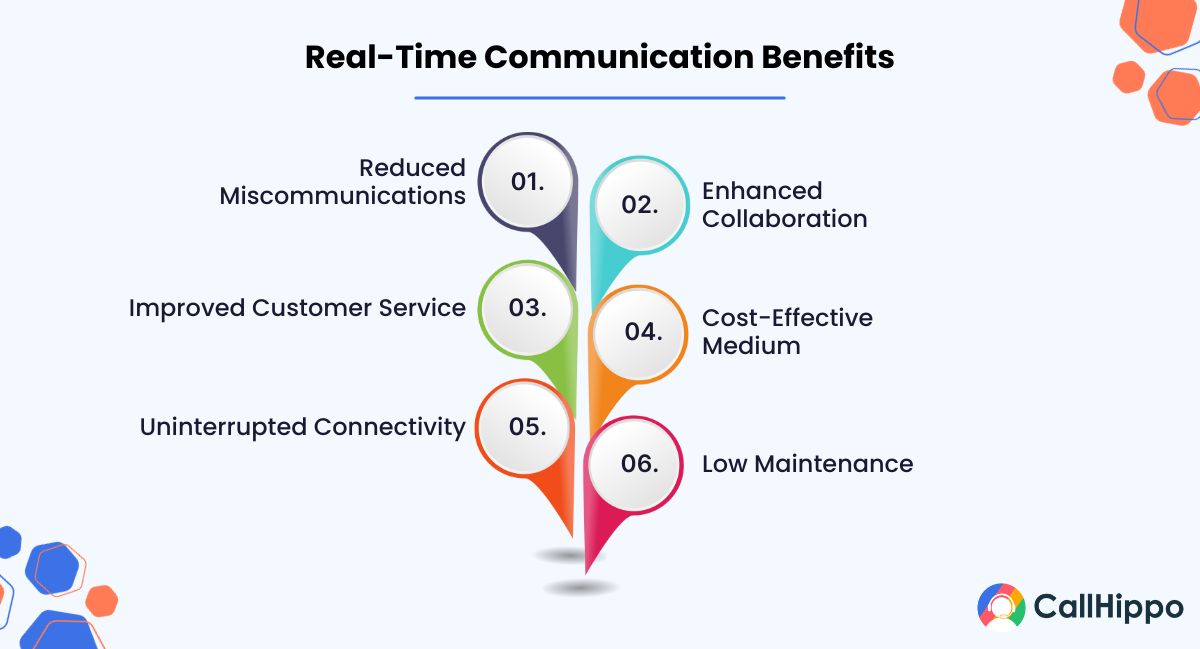Real-time communication is revolutionizing business operations and transforming company fortunes. The ability to rapidly share information, collaborate in real time, and make quick decisions is critical for success in today’s fast-paced business environment.
According to recent research, a staggering 70% of corporate mistakes are caused by poor communication. Just imagine the positive impact on your bottom line if those errors could be prevented. With real-time communication tools, your team can work together seamlessly across locations, time zones, and departments.
Decisions that once took days can now be made in minutes. Customer issues can be addressed instantly, boosting satisfaction. Perhaps most importantly, real-time communication software enables the agility needed to capitalize on new opportunities.
Read on to discover how implementing real-time communication solutions can optimize workflows, empower employees, and take your business performance to the next level.
Let’s get started –
Real-time communications (RTC) refers to technologies that allow instant transmission of information between two or more parties.
The main benefits of real-time communication are reduced miscommunications, enhanced collaboration, improved customer service, uninterrupted connectivity, etc.
There are two main categories of real-time communication based on the directionality and simultaneity of the data transmission, and those are half-duplex and fully-duplex.
What is Real-Time Communications (RTC)?
Real-time communications (RTC) refer to technologies that enable the instant transmission of information between two or more parties. RTC facilitates real-time interactions through mediums such as voice, video, and messaging.

One key pain point addressed by real-time communications technology is the inability to have spontaneous, interactive conversations from a distance. One-way channels made it impossible to have back-and-forth conversations in real time if the parties were geographically separated.
RTC eliminates this with solutions like phone calls, video conferencing, and instant messaging. People can now communicate from afar with negligible latency or transmission delays. This enables seamless, real-time discussions, as if the parties were face-to-face.
Friends can catch up, families can check in, and colleagues can collaborate – all in a spontaneous and interactive way. RTC bridges geographical distances, enabling a type of real-time exchange not possible before.
Types of Real-Time Communications (RTC)
Real-time communication enables the instant transmission of information between parties, facilitating real-time interactions. There are two main categories of real-time communication based on the directionality and simultaneity of the data transmission:
1. Half Duplex
Half-duplex real-time communication involves bidirectional data transmission but not simultaneous transmission. With half-duplex systems, each party takes turns sending and receiving information. Walkie-talkies are a common example of half-duplex communication, where users press a button to talk and release it to listen.
Only one person can transmit at a time. Other examples include CB radios, intercoms, and two-way taxi dispatch systems. These allow for rapid back-and-forth communication in real-time, but not simultaneous two-way transmission.
2. Fully Duplex
Fully duplex real-time communication allows simultaneous and bidirectional transmission of data between parties. Both parties can send and receive information concurrently. This enables seamless, natural conversations without having to take turns.
Telephone networks are a prime example of full-duplex communication. Landline phones allow both callers to speak and hear each other simultaneously. Other examples include mobile networks, VoIP systems like Skype, video conferencing platforms, and instant messaging apps. These facilitate uninterrupted, real-time exchanges without the limitations of half-duplex communication.
Real-Time Communications Examples
Real-time communication enables the near-simultaneous exchange of information between parties, facilitating real-time interactions.
- Key examples include video conferencing platforms such as Zoom, Webex, and GoToMeeting. These platforms enable multiparty voice and video conversations in real-time, which is particularly useful for meetings and virtual events.
- Video calling apps, such as FaceTime, Skype, and WhatsApp, also enable real-time video chats between peers. The ability to see and hear each other live makes these conversations more natural and personalized.
- Messaging apps like WhatsApp and Facebook Messenger allow real-time text chats between individuals and groups, facilitating instant peer-to-peer conversations. Real-time text chats are convenient for quick back-and-forth exchanges.
Advantages of Real-Time Communications (RTC)
Real-time communication offers many advantages over non-instant forms of communication. The main benefits of online communication that happens in real time are outlined below –

1. Reduced Miscommunications
A major advantage of real-time communication is the reduced chance of miscommunications. Since conversations happen instantly, ambiguities can be clarified on the spot before they lead to misunderstandings. The tone of voice and visual cues also help convey context. This prevents delays caused by asynchronous communications, which can lead to incorrect assumptions.
2. Enhanced Collaboration
Real-time communication methods enable seamless collaboration between colleagues. Team members can brainstorm ideas together, work on documents simultaneously, share screens, and exchange feedback in real time. This brings speed and efficiency to collaborative work. Meetings also become more productive with real-time interactions, rather than just one-way presentations.
3. Improved Customer Service
Did you know that a whopping 90% of Americans use customer service as a factor in deciding to do business with a company? This astonishing statistic underscores the urgent need to improve customer service.
For businesses, real-time engagement with customers via live chat, voice, and video calls delivers superior customer service. Customers get their issues resolved faster without waiting for back-and-forth emails. Agents can better understand customers and provide more effective solutions when they can discuss problems in real-time.
Online communication that happens in real-time is an excellent way for organizations to provide 24*7 support to loyal customers. They can empower their sales and support teams to remain available round the clock with advanced technology such as call forwarding, voicemail, and interactive voice response systems. Your customers have the opportunity to feel heard and are assured that your organization is committed to resolving their problems promptly.
4. Cost-Effective Medium

Communication expenses are a significant concern for all types of organizations worldwide. If you’re looking for innovative ways to reduce costs, implementing unified communications is all you need to do. It is a cost-effective medium that allows employees from different work functions and departments to communicate in real-time.
The best part about online communication that happens in real-time is that companies do not need to spend a lot of money on travel, office rent, or accommodations. Employees can seamlessly collaborate through telecommunication technology, resulting in a significant increase in profitability.
5. Uninterrupted Connectivity
One of the biggest disadvantages of traditional communication networks is that they often result in dropped calls or poor-quality connections. With Internet-enabled real-time communications, such as Voice-over-Internet-Protocol (VoIP) platforms, employees can enjoy high-quality calls without any interruptions.
No time lags or communication delays occur through real-time communications, resulting in greater productivity as employees can access the information they need instantly. Communication is clear, and there is no chaos or confusion. This enables key stakeholders to make informed decisions and achieve strategic goals more quickly.
6. Low Maintenance
With unified communication systems, maintenance and upgradation are seldom an issue. Most reliable VoIP service providers offer comprehensive after-sales support and promptly address any technical problems or glitches. Real-time communication software is easy to maintain, with minimal downtime and outages.
User-friendliness is another parameter where real-time communications systems score high! It is a myth that you have to be highly tech-savvy to operate unified communications platforms. They are navigable and easy to operate; hence, most employees can start using these tools instantly without any technical training.
Future Trends in Real-Time Communications
As networks, devices, and software advance, so too do the capabilities for instant connectivity. Technology has changed the way offices are operating around the globe. We are witnessing an increase in remote work options and flexible job arrangements. In such a scenario, traditional communication systems lose relevance as they inhibit team collaboration.
Several key trends are shaping the future of real-time communications solution and enabling next-generation applications. The main trends that will influence future advancements in real-time technology are outlined below:
1. Advances in Real-Time Transport Protocols
Newer real-time transport protocol (RTP) continues to emerge, improving the transmission of real-time data over networks. Protocols like RTP, SRTP, and WebRTC’s implementation of RTP aim to optimize latency, jitter, and packet loss for time-sensitive communications. As these protocols evolve, they enable higher-quality real-time interactions.
2. Growth of Real-Time Communications Vendors
Specialized real-time communications platforms from vendors are gaining popularity. They provide building blocks like programmable voice, video, and messaging to enable real-time interactions in third-party apps and services. The rise of these platforms demonstrates the growing demand for real-time capabilities across industries.
3. Advancing Screen Sharing and Remote Collaboration
Screen sharing and remote collaboration tools are advancing to offer higher resolutions, multi-user screens, and device streaming. These improvements allow for more natural and productive real-time collaboration in remote teams. Vendors are also focusing on the optimization, security, and flexibility of enterprise screen-sharing solutions.
4. Leveraging AI to Enhance RTC Apps
Artificial intelligence has the potential to take real-time communication software like virtual assistants and chatbots to the next level. With natural language processing and conversation modelling, AI can enable faster, smarter, and more natural interactions. As AI improves, expect to see it powerfully augment RTC applications.
You May Also Read: How to Get a Virtual Number for WhatsApp
The Final Word
The real-time communications market is increasing and is projected to reach $45.91 billion by 2027. As businesses expand beyond geographical boundaries, it is essential to utilize the latest technological tools to meet customer expectations and make informed, data-driven decisions.
Investing in unified communications is the ideal solution to enhance your workforce’s efficiency and boost customer engagement levels. CallHippo is a pioneer in virtual telephony, providing businesses with customized solutions to meet their calling needs. It offers virtual phone numbers in over 50+ countries, like a Singapore virtual number, Finland phone number, UK phone numbers, etc., and has multiple real-time communication platforms.
As a credible and reputable market leader, CallHippo is there to help you assess your business requirements and get you the best unified communications system. So jump aboard and get to know more about the various real-time communication software available today to transform your business fortunes!
FAQ-
What are the common technologies used for real-time communication?
Common technologies used for real-time communication solutions include:
- Voice over IP (VoIP) for audio calling
- Video conferencing platforms for video chat
- Instant messaging apps for real-time text chat
- Social media messaging for real-time conversations
- Multiplayer game platforms for real-time coordination
- Emergency response systems for time-sensitive data transfer
What is WebRTC, and how does it relate to real-time communication?
WebRTC (Web Real-Time Communication) is an open-source project that enables web browsers to support real-time communication capabilities without requiring plugins. WebRTC provides APIs and protocols that allow voice calling, video chat, file sharing, and peer-to-peer data transfer right within web pages. Overall, WebRTC simplifies the addition of real-time interactions to web platforms.

Subscribe to our newsletter & never miss our latest news and promotions.









